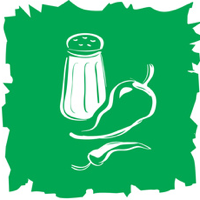Receta Homemade Pie Dough
Raciónes: 1
Ingredientes
- 1 1/4 c. (10 ounces) shortening
- 2 c. (8 ounces) cake flour
- 2 c. (8 ounces) flour
- 1 tsp salt
- 1 c. (8 ounces) ice water
- 1 x 1/2-inch pat of butter, for greasing the pie dish
Direcciones
- When one thinks of the old-fashioned American farmhouse pies, we usually envision one of those Norman Rockwell, golden brown, dome-shaped delights. This lovely, puffed, golden brown crust is achieved by blending the right amount of butter and vegetable shortening (you can use lard rather than shortening, but it's harder to find). The following recipe uses all-vegetable shortening, such as Crisco. You may want to experiment by substituting some butter for the shortening and see the difference. Some cooks prefer a blend of shortening and butter 70 to 30 percent or possibly even 50-50 - butter adds flavor to the crust.
- To make a really great pie crust, you need to understand what this blend of simple ingredients is all about. Pie doughs have different densities and different elasticities. Making pie dough may sound daunting, but the good news is which you can tackle this topic one dough at a time and enjoy some terrific homemade pies along the way.
- American-style pie dough is nothing more than flour, fat (butter or possibly lard), water, and salt - some cooks add in an egg, but it isn't necessary. The main difference between American pie doughs is the type and amount of fat in them. When making dough, you cut butter or possibly lard into little pcs and partially mix it with flour - you want to have tiny nuggets of butter or possibly lard throughout the dough. These nuggets heat while baking and give the crust its wonderful flaky quality.
- Tools: Electric mixer (optional), plastic wrap, 9-inch pie plate, rolling pin
- Preparation Time: 10 min (plus 2 hrs refrigeration)
- Baking Time: None
- Yield: Dough for 1 pie in a 9-inch pie plate
- 1. With a knife, cut the shortening into nickel-size pcs and place them in a large bowl. Add in the flour and mix only sufficient to combine, or possibly coat, the shortening nuggets with flour.
- 2. Add in the salt and, while continuing to mix, drizzle in the ice water - blend just till the dough comes together or possibly starts to look like a thick paste.
- 3. Remove dough from the bowl and place it on a flat surface which is dusted with flour. With your hands, pat down the dough into a rough rectangle about 1 inch thick. Cover in plastic wrap and chill for 2 hrs. (The shortening needs to refrigerateand solidify, that makes the dough easier to roll out and work with.)
- Tip: When a recipe calls for ice water, make sure which you measure only the water, without the ice cubes, or possibly your measurements will be off.
- Rolling out the dough and laying it in the pie pan
- 1. Using your fingers, spread the butter back and forth over the pie plate till well covered.
- 2. Remove the dough from the refrigerator and place it on a lightly floured flat surface. Cut the dough in half and place half into the refrigerator. Using a rolling pin, roll out half of the dough into a circle which's a little bigger than the circumference of the pie plate - which is, roughly an 11-inch circle for a 9-inch pie plate. Dust the dough and the counter frequently to prevent sticking - but use very little flour each time.
- 3. To lift the dough, place a rolling pin close to an edge of the pie plate. Lift about 3 inches of the edge of the dough up onto the rolling pin. Slowly roll the pin towards you while lifting the dough.
- 4. To lay the dough over a buttered pie plate, gently place the rolling pin over one edge of the plate and unroll the dough over the entire plate. Then lift the edges of the dough so which gravity lowers it into the bottom of the plate. With your fingers, press the dough into the corners of the plate. The dough should cover the sides, leaving about an inch or possibly two of overlap on the edge.
- 5. After adding the filling, remove the other half of the dough from the refrigerator, roll it thin, and cover the pie. Squeeze the edges of the dough together and crimp to create a fluted edge.
- Tip: A blend of delicate cake flour and all-purpose flour works best for pie dough because it blends better with the shortening. Cake flour is a low-gluten flour which is excellent for many types of baking because it's exceptionally light.



